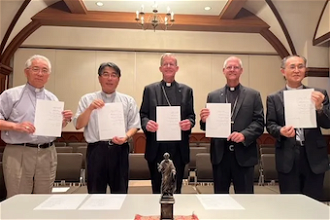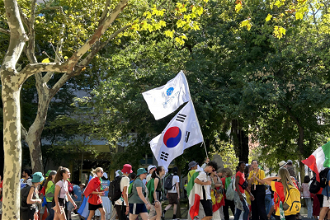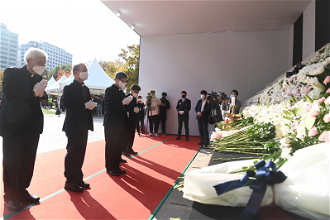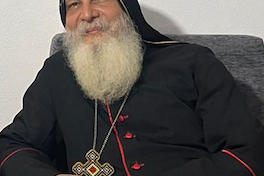'A little piece of El Salvador in Southwark' - Dedication of Romero Cross

Archbishop Smith blesses Romero Cross - image Sophie Stanes
Archbishop Peter Smith presided at an Ecumenical Service of Prayer with the blessing and dedication of the Romero Cross and Memorial at Saint George's Cathedral in Southwark, on Thursday evening.
The Cross was commissioned by The Archbishop Romero Trust in conjunction with the Cathedral and CAFOD. It contains two relics of Archbishop Romero, who was martyred while celebrating Mass on 24 March 1980 in the chapel of The Divine Providence cancer hospital in San Salvador. The relics are a piece of the blood-stained alb he was wearing at the time and his skull-cap.
The Cross was designed and painted by the renowned Salvadoran artist, Fernando Llort, who was present at the ceremony along with the Salvadoran Ambassador, HE Werner Matías Romero, Archbishop Romero's brother, Gaspar, and members of the El Salvador and Spanish-speaking communities.
Hymns at the service were in English and Spanish. Bishop John Rawsthorne of Hallam and the Romero Trust, Bishop Alan Hopes of East Anglia, Bishop Richard Moth of the Forces and Bishop Howard, Auxiliary Emeritus in Southwark, attended the service and one of the ecumenical representatives was the Very Reverend Dr John Hall, Dean of Westminster. who read the Gospel.
Monsignor Ricardo Urioste, 88, who had been Archbishop Romero's Secretary and Vicar General in San Salvador, gave the homily.
The Cross was also dedicated to the memory of Bishop Michael Evans, who died at the age of 59 of cancer in July 2011. Bishop Michael of East Anglia was a Southwark priest, who was much loved as parish priest of Tunbridge Wells, before his elevation to the episcopacy. Bishop Michael was a great admirer of Archbishop Romero and a co-founder of the Romero Trust. Canon John O'Toole, the Cathedral Dean and a friend of Bishop Michael, gave a tribute to him.
After the service, there was a reception in the Amigo Hall, during which the Salvadoran Ambassador said: "So, with the presence of the Romero cross, this place will truly be a 'pedacito de El Salvador' - a little piece of El Salvador – here in the centre of London."
For a more detailed report see: http://polycarpi.blogspot.co.uk/2013/09/london-cathedral-inaugurates-romero.html
The text of Monsignor Ricardo Urioste's homily follows:
We are here at the invitation of the Archbishop of Southwark, Peter Smith, and the Archbishop Romero Trust, for the Blessing and Dedication of the Romero Cross.
This cross will remind us what Jesus told us, “Anyone who does not take his cross and follow in my footsteps is not worthy of me” (Mt.10,38). It will also remind us of Monsignor Romero who lived day by day taking the cross that the Lord gave him until his martyrdom.
We also remember with affection the late bishop of East Anglia, Michael Evans, who was such a strong supporter of the Romero cause.
Today, I would like to recall three essential characteristics of Monseñor Romero's life.
First of all, Romero was a man of God, a man of deep prayer.
Second, Romero was a man of the Church.
Third, Romero was a man for the people, especially for the poorest, and for those who suffer the most.
First, Archbishop Romero was a man of God, a man of prayer.
Shortly before his ordination to the priesthood in Rome, he wrote: "This year I will surrender totally to God. My Lord, please help me and prepare me. You are my All and despite my nothingness, you lovingly desire that I become much. Together with your All and my nothingness we shall do much."
I was privileged to travel to Rome twice with Monseñor Romero when he was the Archbishop of San Salvador. We went together to St Peter's Basilica. He knelt down before the altar and I knelt next to him. After a long while, I stood up. He was still in deep prayer and I said to myself: "One must follow this man because he is following God."
Romero’s life was always deeply rooted in prayer. He once said in a homily: "We really lead outward-looking lives. Just a few people truly lead inward-looking lives, and this is why there are so many problems ....
In each person's heart, there is something like a small, intimate cell, where God comes to speak alone with each person. And this is where a person determines his or her own destiny, his or her own role in the world. If we were to enter this small cell when we are in trouble and would listen to the voice of the Lord who speaks through our conscience, how much would we improve the environment, society, and the family?"
I believe that Oscar Romero waited every day for our Lord's visit to his inner cell.
On March 2, 1980, only twenty days before his death, Romero said: “If it weren´t for my prayer life, through which I try to keep myself in unity with God, I would be no more than what Saint Paul calls a clanging cymbal.”
Romero was not a clanging cymbal. His voice was the voice of the voiceless. And his clarity of purpose derived from his prayer life.
When we see a fruitful tree, we know that its roots are deep in the ground. When we look at Monseñor Romero´s fruitful life, we know that his soul was deeply rooted in God through prayer.
Second, Archbishop Romero was truly a man of the Church. When he was ordained bishop, he chose as his motto: “Be of One mind and heart with the Church”.
This motto meant three things to Monseñor Romero:
One, Be one with the Church through prayer
Two, Love and serve the poor
Three, Be Faithful to the teachings of the Church
As well as the Gospel, the writings of the popes, the documents of the Vatican Council, and the church’s social teaching always ruled his life.
What did “the Church” mean to Romero? He thought that the Church should be a humble and simple Church. In 1978, he said: “Dear brothers and sisters, this is the glory of the Church: to undergo Christ´s kenosis. Because of this, it has to be humble and poor. A lofty church, dependent upon earthly powers, self-sufficient and full of pride, is not the church of St Paul´s kenosis.”
And this is precisely what our Pope Francis confirmed at the beginning of his papacy, when he said,
“I wish to have a poor church for the poor.”
This was the kind of Church that Monseñor Romero dreamed of. This is the Church that he longed for and prayed for.
When Romero spoke about the Church, he was not just thinking about bishops and priests. He also meant lay people. “You are the most important ones in the Church, you who are married, professional people, business people. You run the world with your daily work and you must sanctify it by doing God´s will.”
I remember once when he brought together the archdiocese´s theologians for a consultation. He listened to everyone and asked questions and took notes. The meeting lasted for a couple of hours.
Later, when he went out to the street, he approached a man who looked as if he was homeless. I thought he was going to offer him some help. To my surprise, instead he asked this man the same question he had asked the theologians. To Romero, street beggars were also the Church.
In 1978, Romero wrote as follows to Cardinal Baggio in Rome. Cardinal Baggio was the prefect of the Congregation for Bishops.
“I have tried to proclaim the true faith without detaching it from life, in order to offer everyone the entire richness of the Magisterium of the Church as well as to maintain firmly the unity of the Church represented by the Roman pontiff….
Faithfulness to the Church´s teachings provokes accusations and disdain; whereas indifference to the Magisterium is rewarded with words of praise and promising prospects.”
This letter to Cardinal Baggio shows how Monseñor Romero´s death is intimately linked to the Magisterium of the Church.
In a homily in 1978, Monseñor Romero said: “I shall die, God willing, a faithful follower of Peter, the Vicar of Christ.
It is easy to preach the theory of the Pope´s Magisterium. But when one tries to put it into practice – to incarnate the Magisterium´s redeeming teachings in the history of a suffering people such as ours – that is when conflicts arise.
And I have not become disloyal. Never! To the contrary, I feel I am now more faithful because I am under trial. I endure both the pain and the intimate joy of proclaiming, not only with my lips but also with my whole life, in this community entrusted to me, the doctrine that I have always loved and in which I have believed.”
Romero certainly endured much suffering, to the point of offering his life when he was murdered celebrating the Eucharist.
This is why I believe that Monseñor Romero was a martyr for the Magisterium of the Church.
Third, and finally, Archbishop Romero was a man for the people, a defender and servant of the poor.
Perhaps a phrase of his helps us understand this facet of his life: “The Pastor should be where there is suffering”
And where there was suffering is where Romero was all his priestly life, ever since he was a seminarian and young priest until the end, when he was a 62-year-old archbishop.
Some people think that Oscar Romero experienced a conversion at a particular moment during his life as archbishop. I disagree. He was always someone who sought to do God´s will and God showed His will to him step by step.
Romero was like the blind man from Bethsaida who was cured of blindness by Jesus. Putting spittle on the man´s eyes and laying his hands on him, Jesus asked if he could see anything. The man, who was beginning to see, replied: “I see people; they look like trees as they walk around.”
Then Jesus laid his hands on the man's eyes again, and now he saw clearly. Something similar happened to Oscar Romero. He always loved the poor, but perhaps at first in a paternalistic way. But the Lord touched his eyes, and he began to ask himself, “What else can I do for the poor and the suffering?”
And as the Lord touched him again, Oscar Romero began to see more clearly. He never talked about a conversion in his life, but he did speak about the Lord leading him to evolve.
Jesus has told us that entrance to Heaven will be determined by what we did to help the poor: “I tell you, in so far as you neglected to do this to one of the least of these, you neglected to do it to me.”
About a month before he died, Romero said: “We want a Church that is truly shoulder to shoulder with the poor of El Salvador. This is how we come to understand more clearly the mystery of Christ who becomes human and poor for our sake.”
For Oscar Romero, closeness to the poor draws us closer to the suffering Christ. He tells us: “There is a way to know if God is near us or is far away: God is close to all those who care about the hungry, the naked, the poor, the disappeared, the tortured, the prisoner, the suffering.”
Four months before his death, when he knew his life was threatened, Romero said: “I will not abandon my people.
Please, pray that I may be loyal to my promise to take all the risks that my ministry demands of me.”
One month before his death, Romero went on a retreat. In his notebook we can find some of the most beautiful words he ever wrote: “I am frightened of a violent attack on me. I find it hard to accept a violent death, quite possible under the current circumstances. Father Azcue (his spiritual director) encouraged me by saying that I should be willing to offer my life for love of God regardless of how I die. The Lord helped martyrs. If necessary, I will feel God´s closeness as I offer him my last sigh. But more precious than offering my death to God is rendering my whole life to him and living solely for him.”
These words are Archbishop Romero’s spiritual testament.
He went on to write: “In faith, I accept my death regardless of how painful it might be. The certainty of knowing that in Christ is my life and death is all I need to be happy. In spite of my sins, I have placed my trust in Him.
Others will continue the work of the Church with greater wisdom and holiness.”
Archbishop Romero offered his death to God, just as he had always offered his life to Him.
In the course of history, three bishops have been murdered in the temple. The first was the Bishop of Krakow, Stanislaus. He was murdered for scolding the Polish king for his sins, that is, for defending morality. The second was the Archbishop of Canterbury, Thomas Becket, who was murdered for defending the Church´s rights and freedoms. And the third was Archbishop Romero of San Salvador, who sought to be faithful to the gospel and to the teaching of the Church. He was murdered for defending the poor.
The first two have been canonized. Perhaps one day, God willing, Monseñor Oscar Romero will be canonized too.
Amen.





















